|
Monday, June 28, 2010
Progress Notes
One of the exhibits we have in the museum never fails to attract attention and stimulate questions. It is a wooden replica of an old style bicycle designed and constructed by the Eldon High School Industrial Technology Department which is under the supervision of Industrial Arts Instructor, Kent Hannah (photos 01 and 02).
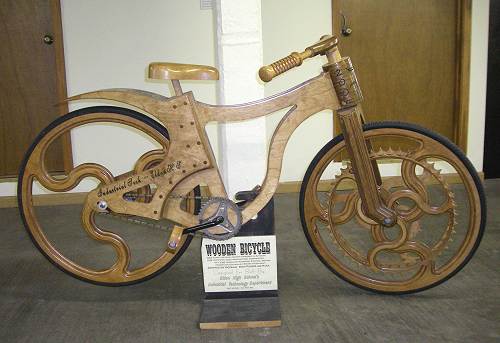
01 Wooden Bicycle
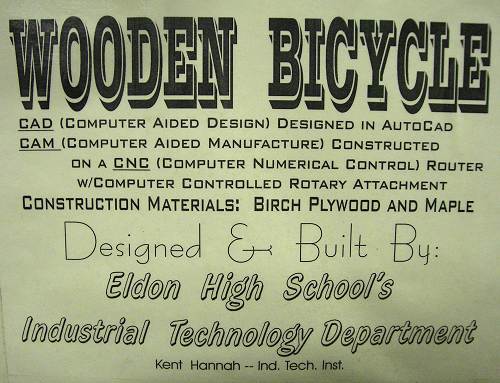
02 Wooden Bicycle Sign You really have to see this skillfully created model first hand to appreciate the attention to detail which was given to its construction.
Here is a photo of Kent published recently in the Advertiser when he was hosting the Midwest Woodworkers Guild from Columbia (photo 03):
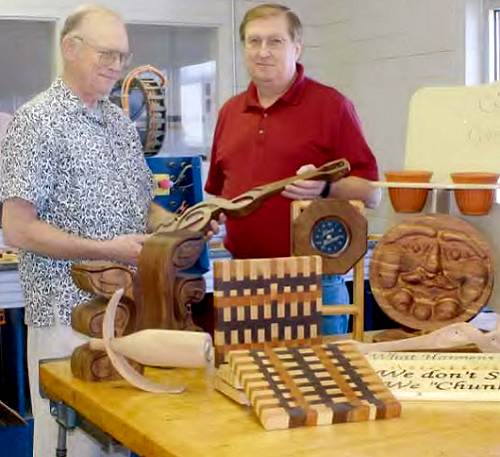
03 Kent Hannah hosting a Woodworking Guild
The Eldon High School Industrial Arts Department recently hosted the Midwest Woodworkers Guild from Columbia. EHS Industrial Arts Instructor Kent Hannah provided the program for the meeting, explaining what EHS students do in class and the level of technology the students are acquainted with. The presentation included displays of projects done by students, samples of work, prototypes and demonstrations of the software and equipment. Midwest Woodworker Guild member Clyde Rea (left) is pictured with Hannah. Rea is also a volunteer in Hannah’s class.
Photo by Tammy Witherspoon Kent has a gift for woodworking. For the members of his family he made a “family stick” which had carved on it all the family names. Here is a photo of his sister, Judith, and her husband, James Myers, holding one of the “sticks” (photo 04):
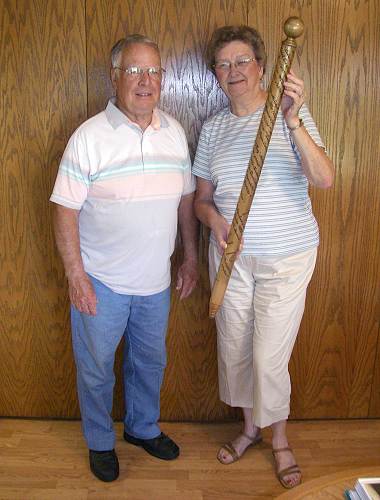
04 James and Judith Hannah Myers with "Family Stick" made by Kent Hannah For their fiftieth wedding anniversary, Kent made a wooden engraved box of wooden dominoes (photo 05).
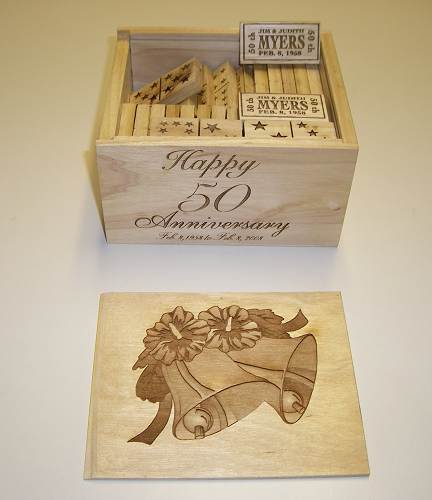
05 Domino Set made by Kent Hannah for Fiftieth Wedding Anniversary of Bob and Judith The skills with wood working runs in the family as Kent’s brother, Barry, made a wooden chest for James and Judith. The names of the Kent siblings are at the bottom of the engraving and the names of their parents at the top (photo 06).
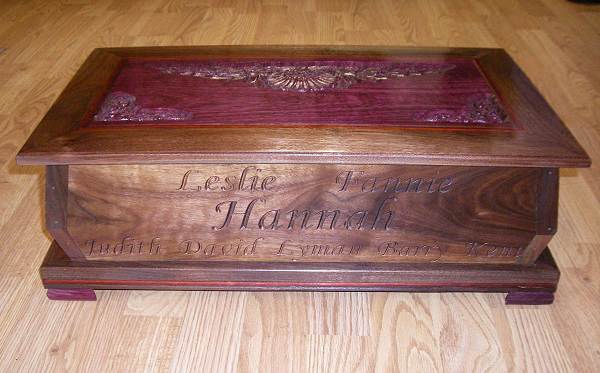
06 Hannah Chest The chest has a top made of purple heart wood from Africa. The orange wood is called “Padula” and is from Central America. The rest of the wood is walnut. The inside lid has a very neatly inscribed dedication alluding to Judith’s careful attention to maintaining and researching the Hannah family history (photo 07).
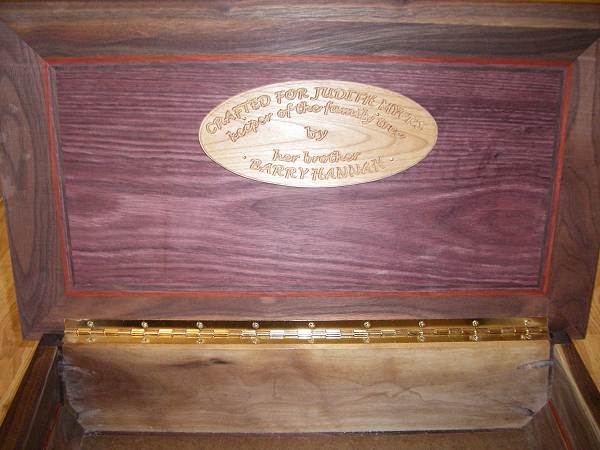
07 Hannah Chest - Inside Here is a photo taken a few years ago in 2003 of Kent and Judith’s family siblings and mother. Since that time in 2006 their brother David passed away (photo 08).
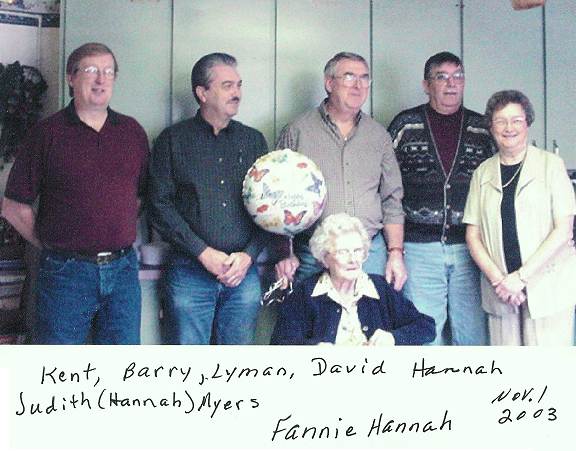
08 Hannah Siblings and Mother Lyman Hannah, third from the left in the photo above, is a professor of Industrial Technology at Central Missouri State University. In this newspaper clipping (not well preserved, unfortunately) he is shown receiving a very distinguished award at a ceremony held in 1989 (photo 08a).
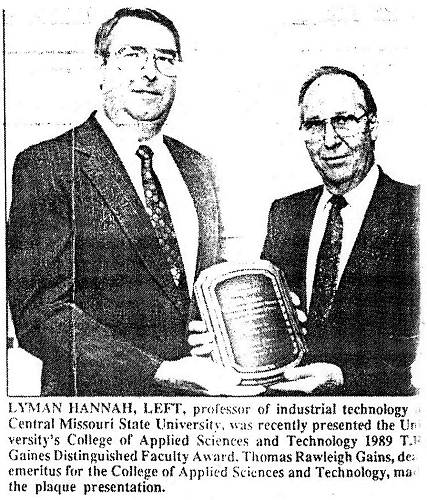
08a Lyman Hannah Receiving Award
Click image for larger viewThe Hannah family’s patriarch in Miller County was Benjamin Hannah (photo 09).
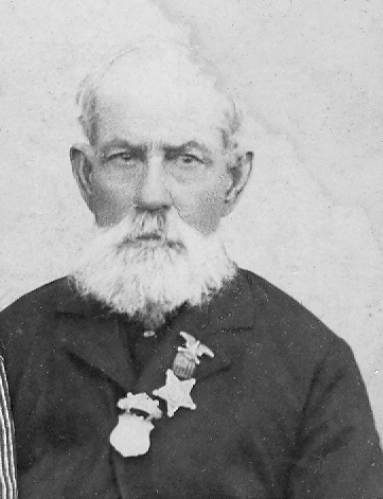
09 Benjamin F. Hannah He was born in 1829 in Pennsylvania but left home at an early age, eventually settling in Miller County around the time of the Civil War. Family military records indicate he served in the Home Guard in 1861. In about 1870 he married Hannah Elizabeth Sampson (her first name is coincidental, but did cause her to use her middle name to avoid being called “Hannah Hannah”) (photo 10).
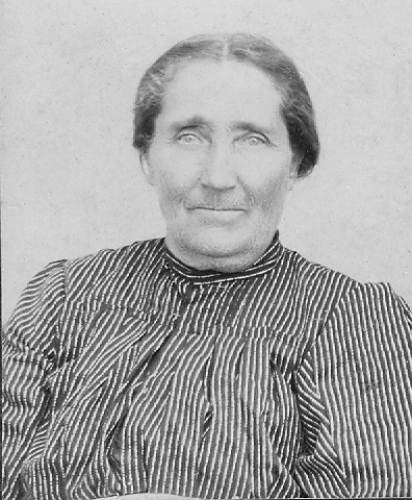
10 Hannah Elizabeth (Sampson) Hannah Hannah arrived in Miller County as a member of a wagon train. We don’t know much about her parents or with whom she was traveling; however, the story goes that the wagon train stopped in Tuscumbia because a number of the members of the train had taken ill (sometime before the 1870’s since she married Benjamin in 1870). Hannah had some money, about three hundred dollars, with which she bought land in the vicinity of Brays Union Church.
Judith told me the land was bought “on the courthouse steps” but Hannah had to have a man purchase it, apparently because women had no standing then for that kind of transaction. Sometime after this she met Benjamin and shortly thereafter they were married. They had three children: Fred, John Frank, and James Albert Hannah (photos 11 - 14).
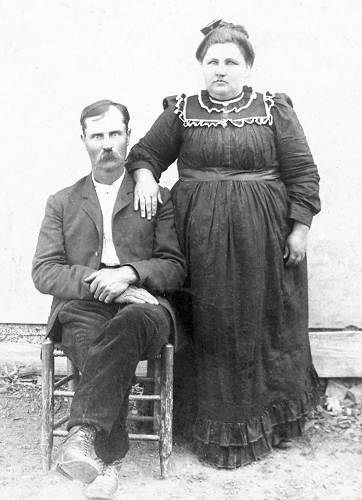
11 Fred and Alsena (Jones) Hannah
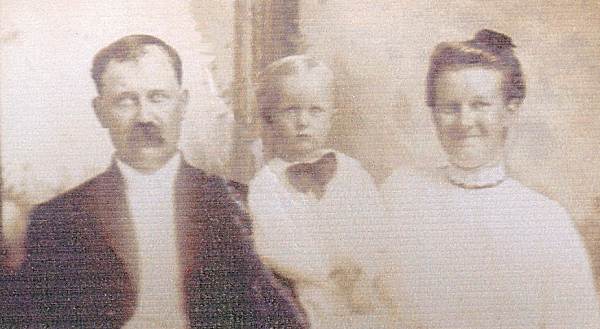
12 John Frank, Clarence and Ida (Wilson) Hannah
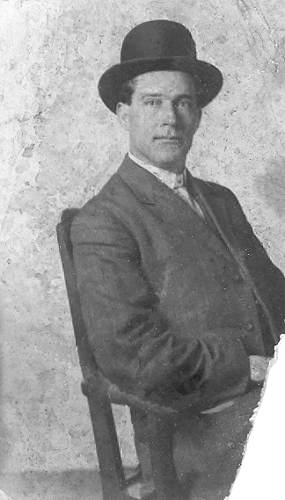
13 James Albert Hannah
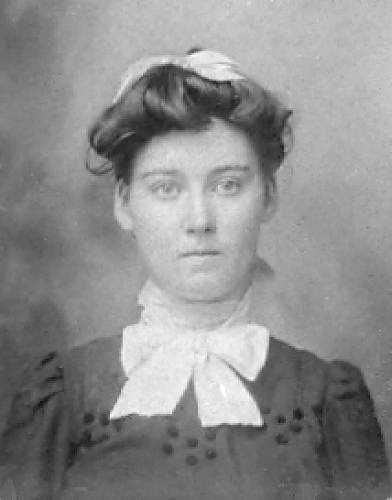
14 Grace (Phillips) Hannah - Wife of James Albert Hannah The Hannah family is best known in south Miller County because of a number of small stores owned by the three Hannah sons. On our own website Peggy Hake wrote an article about Fred Hannah’s store.
I will copy what Peggy wrote here:
FRED HANNAH'S "TRADE RIGHT STORE"
By Peggy Smith Hake
In 1927, Fred Hannah operated a country store in northeast Richwoods Township and called it "Trade Right". It was located a short distance from Mt. Gilead church. Berry school was not too far away. I was fortunate to read some of the old ledgers from this country store. Most of the farming community around Trade Right were customers of Fred's store. Since the store was not far from the Maries County line, some of his customers were residents of both Miller and Maries counties.
Most of the staple goods were available including sugar, salt, coffee, flour, dress materials, thread, shoes, clothing, nails, coal oil, stove pipe, stove black and polish, etc. Later, Trade Right offered gasoline and oil for the vehicles that passed by the old country store. Some of the customers of Trade Right were from the families of Alexander, Baker, Berry, Blankenship, Bolin, Crismon, Clayton, Cross, Crane, Copeland, Cottrell, Dake, Donaldson, Duncan, Fritchey, Hannah, Hale, Humphrey, Healey, Helton, Hickey, Irvin, Jones, Kee, Keeth, Lee, Lawson, Morrow, McKee, Machon, Moss, Pankey, Prater, Pendleton, Patterson, Rowden, Roark, Rollins, Skaggs, Strickland, Sherrell, Sooter, Shelton, Slone, Thompson, Veasman, Vineyard, Watkins, Wilson, Wiles, Willis, Whitaker, and Yoakum.
Frederick/Fred Hannah was the oldest son of Benjamin and Elizabeth (Simpson) Hannah, natives of Pennsylvania. Benjamin was born circa 1830 and Elizabeth circa 1841 (in some records her name was spelled Sampson). They married in Miller County on June 7, 1870. According to marriage records her name was Hannah Elizabeth Simpson, so it is understandable she was called Elizabeth Hannah, not Hannah Hannah! Fred was born in March 1872 and had two younger brothers: John Franklin Hannah b. 1874 m. Ida M. Wilson; and James Albert Hannah b. 1877 m. Grace E. Phillips. There may have been other children I did not find record of.
Fred Hannah married Alcena Jones in October 1896. She was a daughter of James W. Jones and Frances Bowlin who lived in the same community as the Hannah family. In 1927, when Fred was operating Trade Right Store, he was 55 years old. He died in January 1966, almost reaching his 94th birthday and was buried beside Alcena at Brays Union Cemetery. She had died 14 years earlier in 1952.
Judith told me that her grandfather, James Albert Hannah and his brother, John Frank Hannah, had their first store where the old Brays’ Mill is located. The store building is still standing as is the mill (photos 15 and 16).
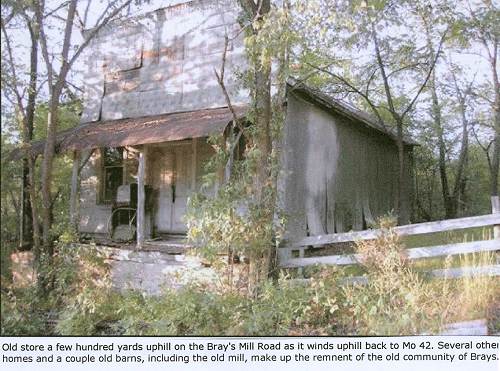
15 Brays Store - First Store of James Albert and Frank Hannah
Click image for larger view
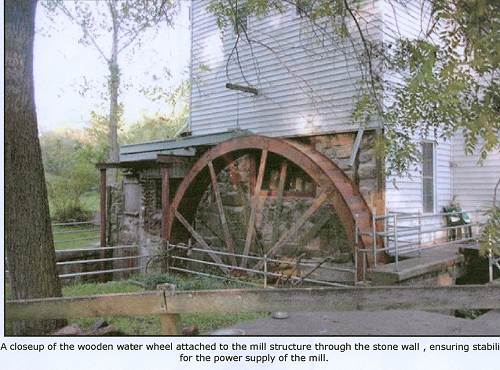
16 Brays Mill
Click image for larger viewThere had been some uncertainty among some members of the recent family about whether or not James Albert and John Frank had the Brays store but Judith found this old cashed check among many others which pretty much proves the Hannahs’ ran the store for awhile at Brays Mill (photo 17).
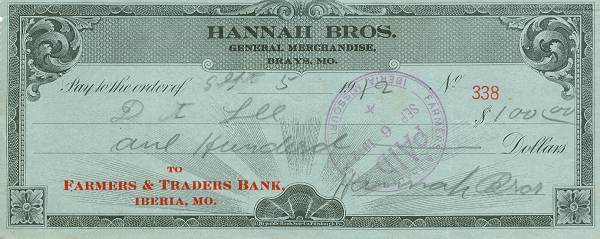
17 Cashed Check from Brays Store James Albert then started a store at a community no longer in existence called the Cross Roads Atwell community. Judith was born in the upper story of this old store (photo 18).
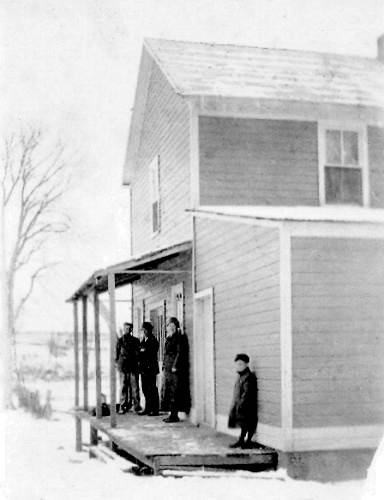
18 Cross Roads Store
James Albert and Grace and Unknown on Porch - Leslie Hannah at End The history of the store as well as the Cross Roads/Atwell area is told on our website.
For continuity I will copy that story here:
Cross Roads/Atwell Community
In the southeast corner of the county, close to the Maries County line, was once a small settlement known as Atwell. The community, located in Richwoods Township, was founded in the 1870s and was named for the Atwell family who ran a general store there.
At one time, Atwell was also referred to as Crossroads. It was located midway between Dixon and Iberia in the southeastern part of Miller County, four miles north of Hancock. The town was established at the intersection of four roads. One road led to Brays, one led to Dixon, another to Iberia and the last one to Hancock. These roads were used by farmers to drive their livestock to Hancock to be shipped to market.
Bart Sloan established the first general store in 1900. A mill for grinding wheat and corn was established in Cross Roads in 1900 but burned down in 1911.
In 1911, a second general store was built and put into operation by J. Ed Barnett. The store was operated for about a year and then was sold. The proud new owner of the store was J.A. Hannah. He enlarged the store and added to the regular stock the buying of rabbits, furs, poultry, and eggs. The store operated under the name "J.A. Hannah and Son".
Cross Roads was a prosperous place. A church was built in 1929. It even had its own cemetery. A school was located by the church known as the Atwell School. At one time it had 75 students attending the school. There were many forms of entertainment at Cross Roads. One of the main attractions was the Christmas play held at the school each year. In 1930, Ellen Baker, who traveled daily from her home in Hancock, was the teacher and R.C. Phillips, also from Hancock, was the school clerk.
The road that led to Brays was the route taken by the mail carrier when delivering his mail to Cross Roads. About twelve mailboxes were maintained. The mail wagon started in Hancock and turned around in Brays. Mail was delivered six days a week.
The settlement of Atwell began to die away in the 1940s. Today dilapidated structures and the charred remains of buildings serve as mute reminders of the former existence of Cross Roads. This community, which showed signs of growth early in the 1900s, is now a ghost of the past.
Ancestral Names: Anderson, Atwell, Bowden, Cannon, Cross, Forbis/Forbes, Glawson, Goodman, Groves, Law, Lee, Morrison, Moss, Pittman, Ponder, Porter, Russell, Schubert, Scott, Thompson, Tyler
To get a better idea where the old Cross Roads community was located, Judith sent me this 1936 plat map of south east Miller County. If you look at the bottom right corner of the map you will find the settlements of Atwell and Cross Roads in sections 10, 11, and 12 (photo 19).
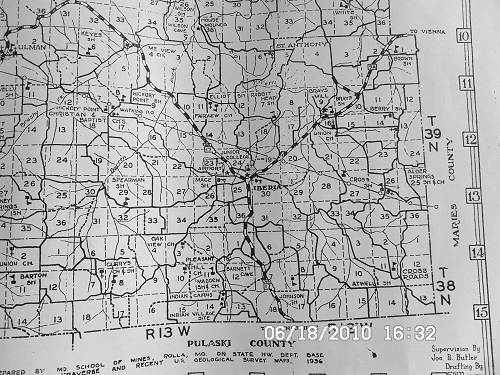
19 Plat Map - 1936
Click image for larger viewJudith told me she recently had made a trip to the Cross Roads store location once owned by her grandfather but all that is left now is the concrete foundation. No building is standing anywhere.
Judith’s father, Leslie Hannah, was featured in an article about the Cross Roads area written by some Dixon high school students several years ago:
Where the Roads Cross
Interviewed and written by Marlene Smith, Glenda Fancher, Rebecca Wotherspoon, Brigitte Jones, Donna Sheehan
We talked with Mr. and Mrs. Leslie Hannah, who live on one of Dixon’s rural routes. Mr. Hannah’s mother and father operated a general store and thus were able to supply us with the following information about Cross Roads (photo 20).
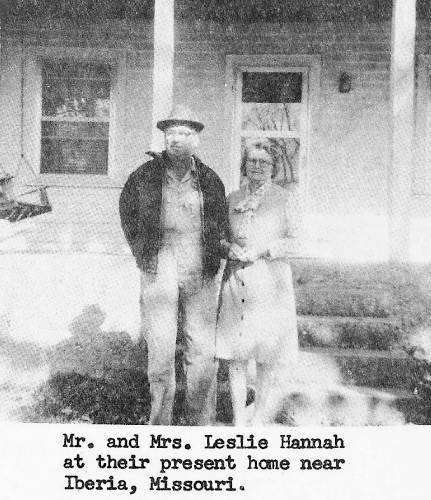
20 Mr. and Mrs. Leslie Hannah Cross Roads was a small town located midway between Dixon and Iberia, four miles north of Hancock. The town was established at the intersection of four roads. One road let to Brays, one led to Dixon, another to Iberia, and the last one to Hancock. These roads were used by farmers to drive their livestock to Hancock to be shipped to market.
The town first came into existence in 1900 when Bart Sloan established the first general store. A mill was established in Cross Roads in 1900 but burned down in 1911. Wheat and corn were ground there.
In 1911, a second general store was built and put into operation by J. Ed Barnett. The store was operated for about a year and then was sold. The proud new owner of the store was James Albert Hannah. He enlarged the store and added to the regular stock the buying of rabbits, furs, poultry, and eggs. The store operated under the name “J.A. Hannah and Son” (photos 21 and 22).
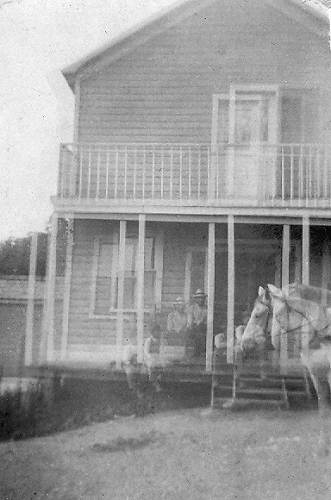
21 Front of Store at Cross Roads
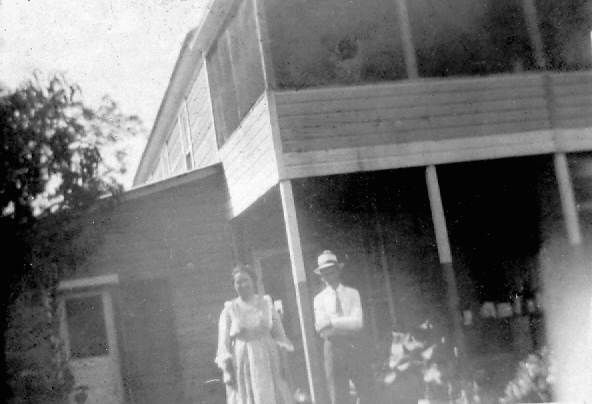
22 Back of Store at Cross Roads - Grace and James Albert Hannah Around 1910-1915 there was a canning factory in Cross Roads. Twenty to twenty four people were employed at the factory. Tomatoes were the main food canned there.
There were two blacksmith shops at the Cross Roads. Barney Tyler owned one from 1913 to 1915. James Albert Hannah built the other one around 1920. It was operated by Leslie Long.
Cross Roads was a prosperous place. A church was built in 1929. It even had its own cemetery. There were four homes right at Cross Roads, but people from all around did their trading there. The town had its own well.
Mr. Hannah told us that he was raised in Cross Roads and attended school there; the name of the school was Atwell. It was a fairly large school, with 75 students attending it at the time Mr. Hannah did. Mr. Hannah related an amusing story to us about a teacher who wanted to teach at the school. Here is that incident:
“A young woman wanted to teach at Atwell school house but the school board didn’t want her. So, the woman said that she would not take any money until she had taught for a month and met all standards and requirements. One day, one of the bigger boys caused some trouble, and the teacher told him to come up to the desk to take his whipping. The boy just turned around and ran out. The teacher was right on top of the boy. The young woman finally got the job!”
Note: for more information about the Atwell School read this article on our website.
There were many forms of entertainment at Cross Roads. One of the main attractions was the Christmas play held at the school each year.
Sometimes in the evenings the folks would gather at somebody’s house and enjoy the live music performed by some of Cross Roads’ citizens. The violin, banjo, and organ were all played. There were so many people at these gatherings that at the hitching post, which was made for eight to twelve horses, there would be as many as thirty to forty horses.
Halloween was another time enjoyed by the boys at Cross roads. They found it amusing to carry off Billy Odom’s wagon. Once the boys carried the wagon six miles away, but the next day they went out and helped him look for it.
To Mr. Hannah, the most important event at Cross Roads was the birth of his daughter. She was the first child of Mr. and Mrs. Hannah. Mr. Hanna said that night he gave the doctor eight $2 bills and received a dollar in change.
Note: This child was Judith.
The circus which used to come through this area took the route through Cross Roads. The circus would stay all night at a farm over across the creek. Mr. Hannah remembered the worst tragedy that occurred in Cross Roads. In 1917 one of the circus animals died and was taken up into the field. A buggy being pulled by horses came close to the dead animal and smelling it, became startled and began running. Two ladies, Mrs. Charlie Irvin and Miss Freda Phillips, were killed when they jumped from the buggy and were struck by the rear wheels.
Note: Judith old me that the Freda Phillips mentioned above was her great aunt being the daughter of Belle Phillips who was Judith’s great grandmother. Here is a photo of Belle in front of the Cross Road Store with her horse and buggy (photo 23). This photo is thought to be of the same buggy which overturned killing the two ladies mentioned above.
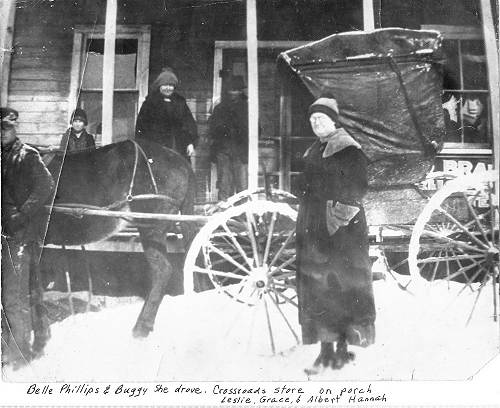
23 Belle Willis Phillips at Cross Roads Store The road that led to Brays was the route taken by the mail carrier when delivering his mail to Cross Roads. About twelve mailboxes were maintained. The mail wagon started in Hancock and turned around at Brays. Mail was delivered six days a week (photo 24).
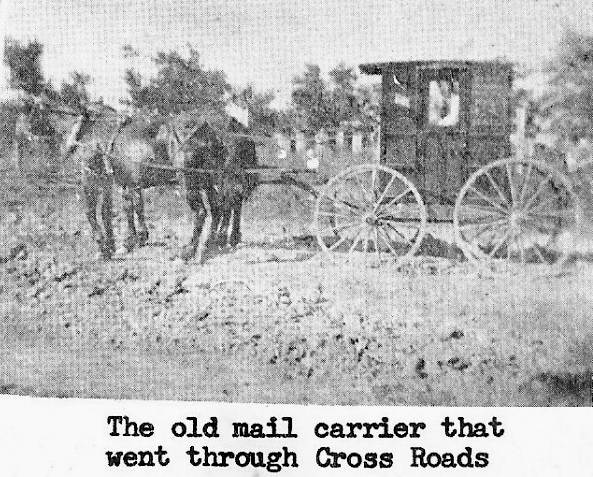
24 Mail Carrier for Cross Roads As Cross Roads prospered, improvements were made. In 1923 the general store added cream to its line of merchandise. During the Depression years, eight to twelve thousand dollars worth of rabbits and furs were sold each year. This amounted to quite a few rabbits, because the store only paid as high as twenty cents a rabbit.
In 1920 a new means of transportation was brought to Cross Roads. The village blacksmith was the first person to buy a car. In 1923 Mr. Hannah’s father, James Albert Hannah, bought a new car for the price of $430.00. In 1935 the first school bus came through Cross Roads. A few people even had telephones.
Even with all the progress Cross Roads was making, it slowly began to die out. In 1939, the day after Franklin D. Roosevelt was elected to his third term, James Albert Hannah closed down his store. By 1941, Cross Roads had completely closed. Most of the people moved away to Fort Leonard Wood.
Today dilapidated structures and the charred remains of buildings serve as mute reminders of the former existence of Cross roads. This community, which showed signs of growth early in this century, is now a ghost of the past.
As noted above, in 1939 James Albert Hannah sold the Cross Roads store. He sold it to Leonard Kehr. Here is a box of records Judith has kept that were from the Cross Roads store (photo 25).
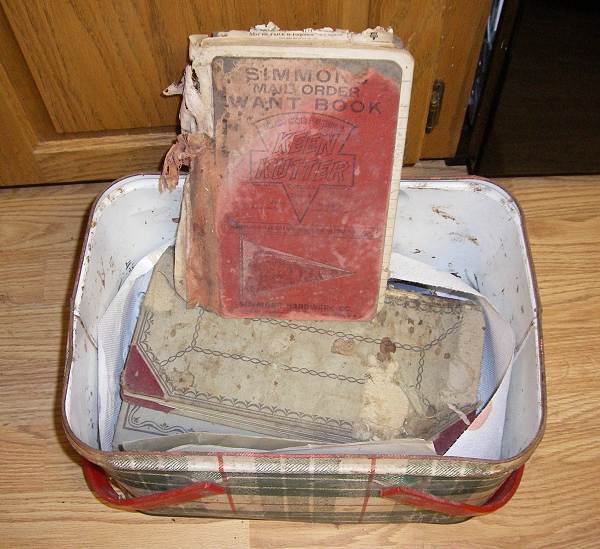
25 Store records from Cross Roads Store Later in 1939 James Albert built a new store on Highway 42 just a short distance north east of Greasy Creek. His son, Leslie, Judith’s father, also worked in the store. In addition, Leslie operated a farm located just a short distance to the northwest of the store on what is now known as Hannah Store Road (photo 26).
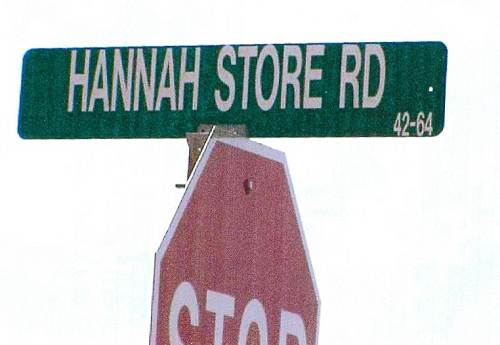
26 Hannah Store Road Sign Leslie’s first house burned but a new one soon was built (photo 27).
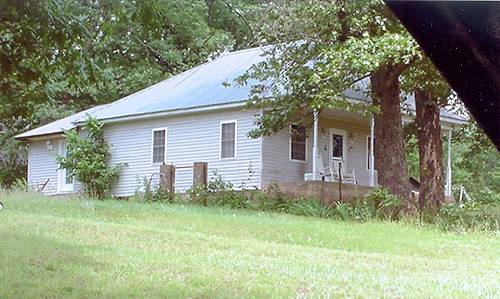
27 Hannah Home on Hannah Store Road Judith attended the “New Brown School” located near her home on Highway 42 (photo 28).
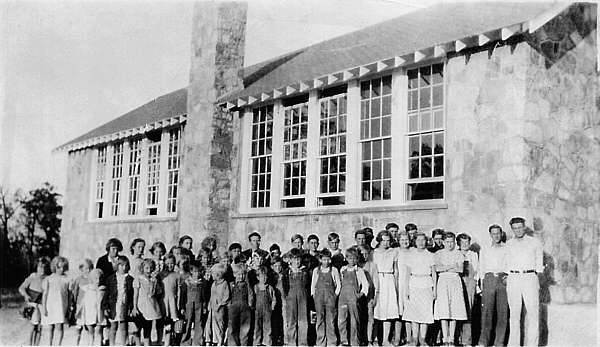
28 Brown School - Last one of Three Three Brown schools existed in this area of the township (T39N R12W). You can read more about the three Brown schools on our website.
I asked Judith how Greasy Creek got its name. I had driven that part of Highway 42 once in a while in the past but never had the opportunity to talk to a local to find out about the name. Judith told me that an old woman lived down the hill from her folks’ store right on the creek. She was a caricature of the image of an elderly Missouri Ozarks woman popularized by cartoonists such as Al Capp, especially due to the fact that she smoked a corn cob pipe.
(Now that isn’t an unusual story. My mother told me that Aunt Jenny (Curry) Bear, wife of her great uncle George Bear, regularly smoked a pipe on the front porch in the evenings after supper. George and Jenny lived over in the Ulman area.)
At any rate the old woman regularly washed her clothing and dishes in the creek, something that was observed by the neighbors who gave the creek its name. If you drive east on Highway 42 you can’t miss the creek. It now is crossed by a big new bridge and the sign heralding the presence of the creek is quite prominently displayed (photo 29).
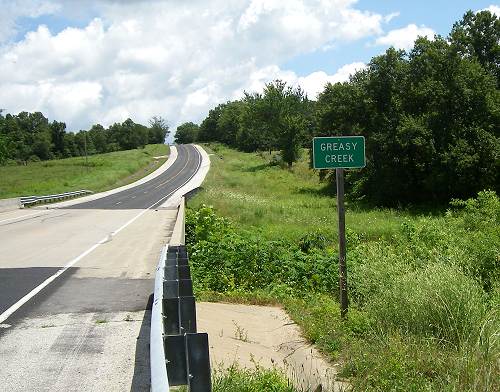
29 Greasy Creek Bridge I have to admit I was curious enough to stop the car the other day when I was over there and proceed to walk to the middle of the bridge. I can report that Greasy Creek is quite clear and has a swift rippling flow over its smooth rock bottom (photo 30).
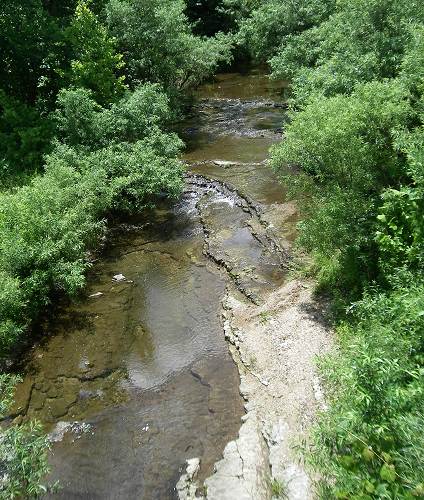
30 Greasy Creek In the 1950’s the Highway 42 Hannah store was leased. In that same time frame James Albert Hannah died in 1956. In 1970 the store burned and no evidence is present now of its existence, the site is now part of a rolling pasture. Here is a photo of some of the business records of the Highway 42 Hannah Store (photo 31).
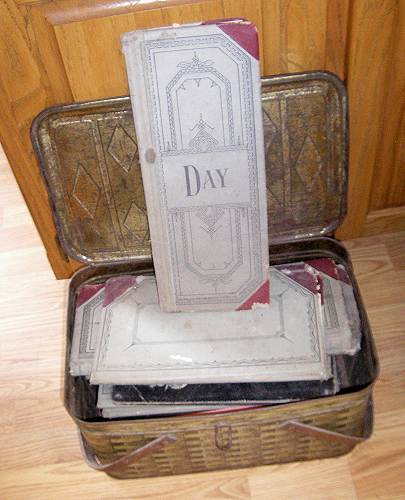
31 Store records from Store on Hiway 42 Road East of Iberia And here is a photo of some of the mills used as currency in the earlier half of the last century in the Hannah stores (photo 32).
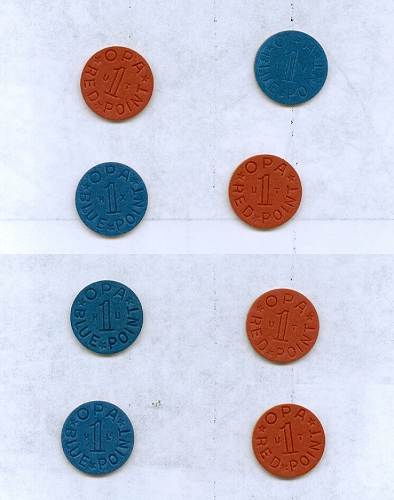
32 Mills
Click image for larger viewSome readers may not remember the use of milles in the past, so I copy below what Wikipedia has to say:
Mill Currency

32a Missouri Mill Token In the United States, the term was first used by the Continental Congress in 1786, being described as the "lowest money of account, of which 1000 shall be equal to the federal dollar.”
The Coinage Act (1792) describes milles and other subdivisions of the dollar:
That the money of account of the United States shall be expressed in dollars or units, dimes or tenths, cents or hundredths, and milles or thousandths, a dime being the tenth part of a dollar, a cent the hundredth part of a dollar, a mille the thousandth part of a dollar, and that all accounts in the public offices and all proceedings in the courts of the United States shall be kept and had in conformity to this regulation.
Tokens in this denomination were issued by some states and local governments (and by some private interests) for such uses as payment of sales tax. These were of inexpensive material such as tin, aluminum, plastic or paper. Rising inflation depreciated the value of these tokens in relation to the value of their constituent materials; this depreciation led to their eventual abandonment. (Virtually none were made after the 1960s.)
Nowadays, most Americans would refer to fractions of a cent rather than mills, a term which is widely unknown. For example, a gasoline price of $3.019 per gallon, if pronounced in full, would be "three dollars (and) one and nine-tenths cents". Discount coupons, such as those for grocery items, usually include in their fine print a statement such as "Cash value less than 1/10 of 1 cent." There are also common occurrences of "half-cent" discounts on goods bought in quantity. However, the term "mill" is still used when discussing billing in the electric power industry as short-hand for the lengthier "1/1000 of a dollar per kilowatt hour". The term is also commonly used when discussing stock prices, the issuance of founder's stock of a company, and cigarette taxes.
Property tax
Property taxes are also expressed in terms of mills per dollar assessed (a mill levy, known more widely in the US as a "mill rate"). For instance, with a millage rate of 5.753 mills, a $100,000 house would be taxed 575,300 mills, or $575.30. The term is often spelled "mil" when used in this context.
The Highway 42 store was the last of the ones owned by the Hannah family. Many people are alive today in the area who remember the family and its stores. I want to thank Judith and James Myers for their hospitality and great assistance in providing most of the photos and history for the Hannah family story.
One very interesting book I have found is the Encyclopedia of Missouri Courthouses by Marian M. Ohman published by the University of Missouri Extension Division in 1981 (photo 33).
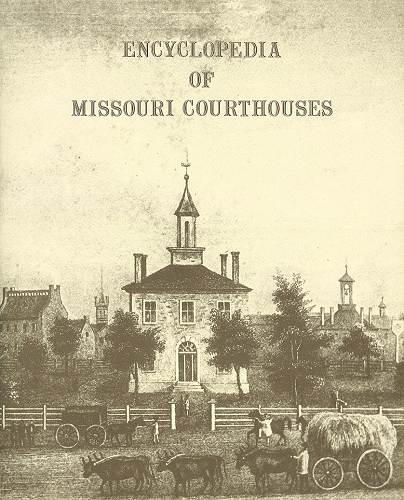
33 Encylopedia of Missouri Courthouses - Jackson County Pictured
Click image for larger viewSince 1973 Dr. Ohman has prepared several projects related to the history of Missouri art and architecture. One of her most encyclopedic works was a complete survey of Missouri’s county courthouses which was the most comprehensive single study of any state in the United States, according to Leonard C. Douglas, Vice Provost, Extension division. Dr. Ohman studied sociology, American history and art history at the University of Missouri-Columbia where she received a Ph.D. in 1973. Since that time she had an appointment with the College of Arts and Science in the University of Missouri Columbia Extension Division as Program Coordinator-Humanities. The photos Dr. Ohman has obtained of the old historic courthouses in Missouri are fascinating due to the differences in style and architecture. And the history of each one in itself is reason enough to read her book. Here is a photo of the Miller County Courthouse built in 1910 which was featured in Dr. Ohman’s book (photo 34).
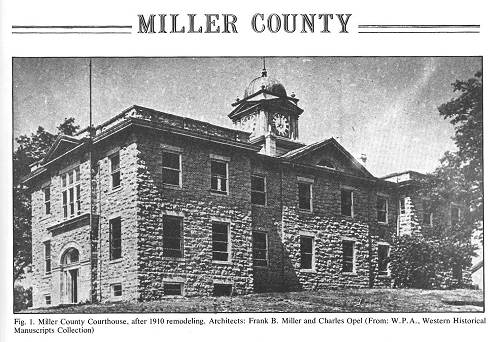
34 Miller County Courthouse from Missouri Courthouses
Click image for larger viewCopied below is Dr. Ohman’s history of the Miller County Courthouse:
Encyclopedia of Missouri Courthouses
Marian M. Ohman
University of Missouri-Columbia Extension Division
Miller County
Miller County attempted to build a courthouse in Tuscumbia in 1838. In February judges appropriated $400 and advertised for construction, but received no bids. The court tried again in 1839, appropriating $250 and appointing Hardin M. Williams superintendent. This time they succeeded when John Davis, one of the judges, submitted a low bid of $199.
The 32 by 20 foot, hewn log building had a stone foundation, rough plank floor, hewn boards covering the cracks (apparently board and batten construction) and a gable roof. A partition wall divided the courthouse into two rooms (photo 35).
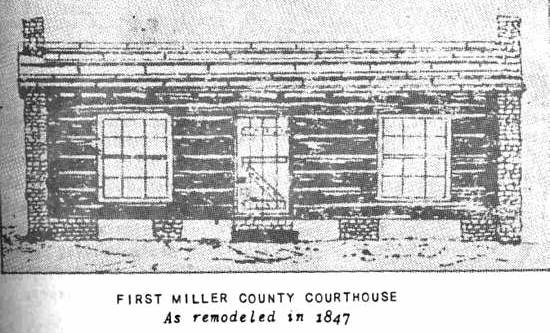
35 First Miller County Courthouse - Remodeled 1847 Davis completed his work during August 1840. Finishing work continued until May 1841. Repairs on the building in 1843 and 1847 still did not provide satisfactory accommodations, and the clerk twice sought quarters elsewhere. Finally, in 1858, as preparations were made for a new facility, the courthouse of 1839-40 was ordered sold to the highest bidder.
Petitions from citizens asked for a new courthouse in 1856, and the court made an initial appropriation of $4,000. The court awarded the contract to Robert McKim and Robert Ainsworth for $6,000 in November 1857. They built a two story, brick, 56 by 40 foot courthouse, on a plan which the court accepted from Owen Riggs, the superintendent. The brick was made locally, but the masonry was of such poor quality the court had it painted with two coats of red paint. The court accepted the completed building in February 1859. This courthouse continued in use into the 20th century (photo 36).
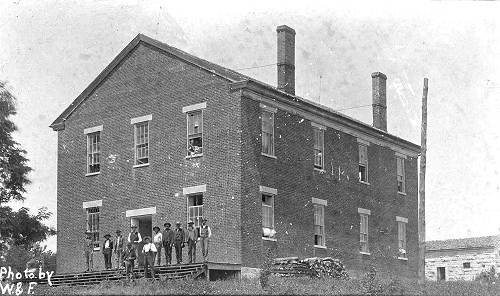
36 Old 1859 Court House
Click image for larger viewNumerous attempts to vote bonds for a new courthouse were defeated, partly because there was some desire to relocate the county seat. In 1909 one prominent citizen encouraged relocation advocates to stop talking about it, because, he said, “Elephants will turn to ants and flies to dianasauruses (sic) before the county seat is removed from Tuscumbia.”
The following month the court decided to repair the old courthouse, for approval by vote was not necessary when repairing county property. On November 6, 1909, the clerk was ordered to contact different architectural firms for a remodeling design. The court then commissioned the Jefferson City firm of Miller and Opel, who presented a plan that reversed the previous arrangement by putting the courtroom on the second floor, with offices on the first.
Wings were added to the north and south of the central block, which had been the 1858 courthouse. The court awarded a contract April 14, 1910, for veneering the sides of the old building with native limestone and making two 28 by 50 foot additions, increasing the size of the building to 110 by 50 feet. P.F. Hauenstein and R.T. Roberts received the contract for $13,800.
Finally, the county did need to pass a $10,000 bond issue to finish the project. W.W. Whitlock received the contract in September 1913 for $8,483 to complete the remodeling. He finished the work in December 1913 (photo 37).
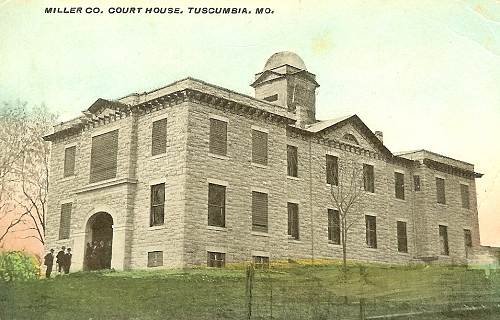
37 Miller County Courthouse - 1913
Click image for larger view
A more detailed history of the courthouse written by Peggy Hake has been presented previously on Progress Notes.
We have on display in our museum blue prints of the courthouse finished in 1913 which were donated by the Dan Thompson family (click on the thumbnail images for a larger view) (photos 38 - 43):
Dan was the local Tuscumbia carpenter who figured out how to design and build the cupola at the top of the old courthouse, something which the contractors from out of town couldn’t figure out. He was said to have been the area’s most ingenuous builder (photo 44).
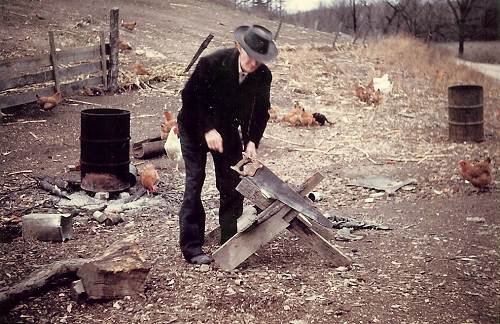
44 Dan Thompson Here is a photo of the opening day celebration of the courthouse in 1913 (photo 45):
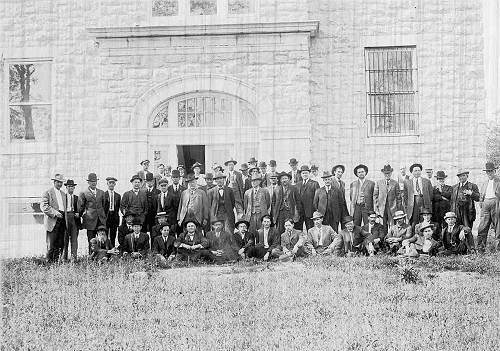
45 Miller County Courthouse Opening - Approximately 1913
Click image for larger viewHere are photos of the cornerstones showing the names of the local contractors and those who were on the county court at the time of its completion (photos 46 and 47):
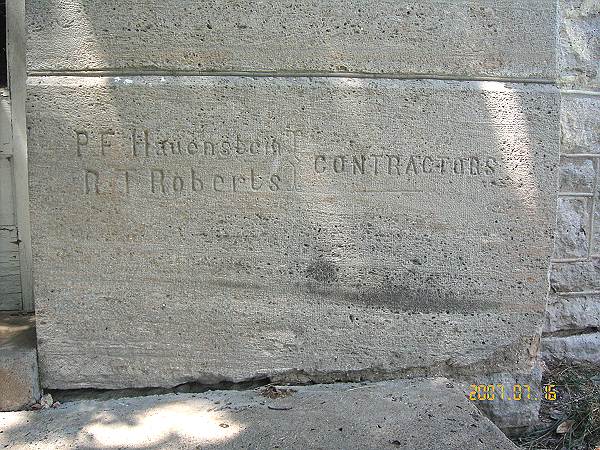
46 Cornerstone Courthouse Contractors
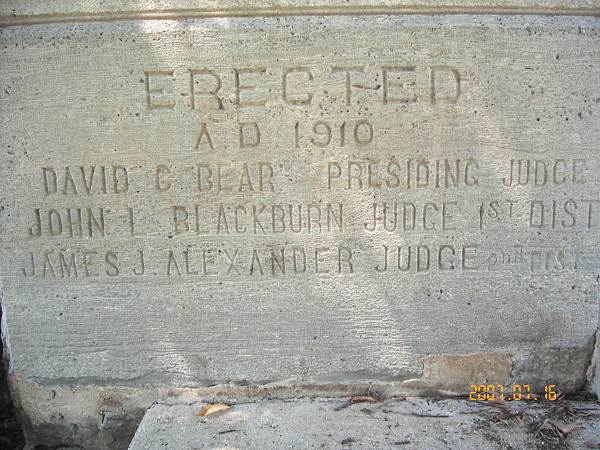
47 Cornerstone Courthouse County Officers I have photos of some of those whose names were on the cornerstones. One of the contractors was Phil Hauenstein (photo 48).
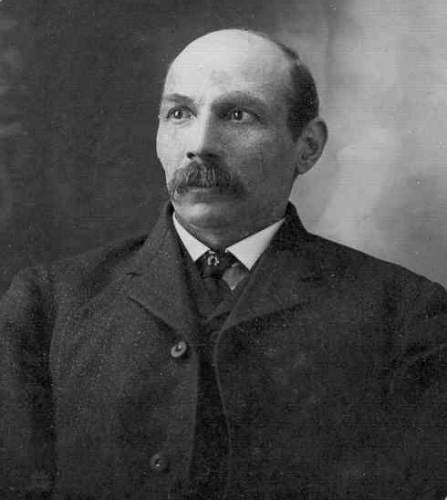
48 Phil Hauenstein Of the names of those on the county court listed on the other cornerstone I have two of the three listed, David C. Bear (photo 49) and John Blackburn (photo 50).
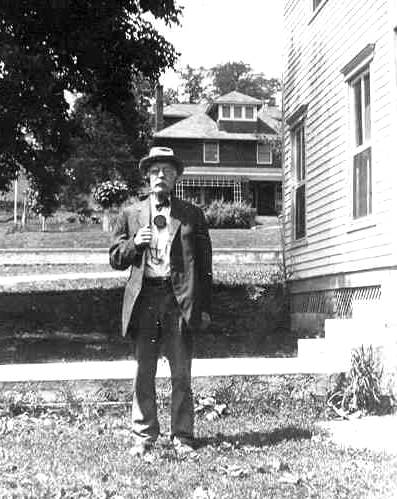
49 David C. Bear

50 John Blackburn
A couple of weeks ago I arrived at the museum early in the morning and saw a couple of big cylindrical stone formations on either side of the runway to the lower level entrance (photos 51 and 52).
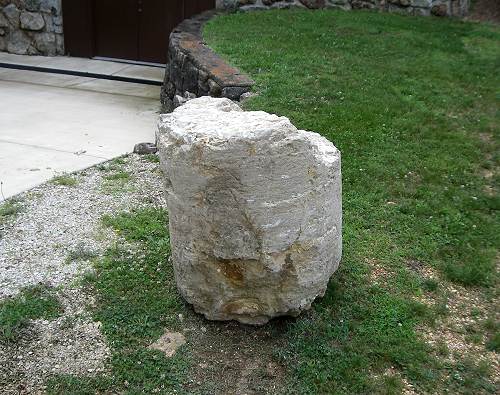
51 Core Sample
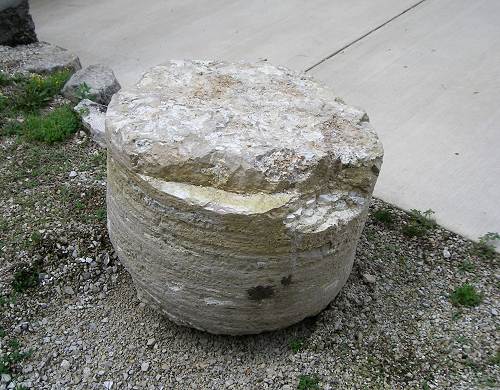
52 Core Sample I had no idea what they were but didn’t think they would have fallen out of the sky to have been placed so symmetrically across from each other beside the runway. Bill Prather was museum host that day and he knew immediately what they were. “They are core samples,’ he said, which to me, at least, meant they were derived by human intervention of some type and that they purposely were placed where I found them. So, knowing that Layne Helton is a good friend of the museum and always looking for things of interest for us to display, I called him and sure enough, he had brought the core samples up from the new bridge construction site on the Osage River just down the hill from the museum. He told me that the engineers needed to know what type of earth and rock layers subterraneously they would be encountering in the holes drilled for the bridge piers. For example, if a layer of soft rock, gravel or a break in the continuity of the sample was present, the pier would be less firmly fixed in the ground and should be placed at another location. The following is copied from Wikipedia:
Core Drill
A core drill is a drill specifically designed to remove a cylinder of material, much like a hole saw. The material left inside the drill bit is referred to as the core.
Core drills are used for many applications, either where the core needs to be preserved (the drilling apparatus used in obtaining a core sample is often referred to as a corer), or where drilling can be done more rapidly since much less material needs to be removed than with a standard bit. This is the reason that diamond-tipped core drills are commonly used in construction to create holes for pipes, manholes, and other large-diameter penetrations in concrete or stone.
Core drills are used frequently in mineral exploration where the coring may be several hundred to several thousand feet in length. The core samples are recovered and examined by geologists for mineral percentages and stratigraphic contact points. This gives exploration companies the information necessary to begin or abandon mining operations in a particular area.
Core drills come with several power choices including electric, pneumatic, hydraulic (all of which require power sources, such as a generator).
Here is a photo of a core drill, although it is smaller than the ones used for the core samples pictured above (photo 53).

53 Core Drill And here is a photo of the nearly completed bridge which Ginny Duffield took the other day for the newspapers (photo 54).
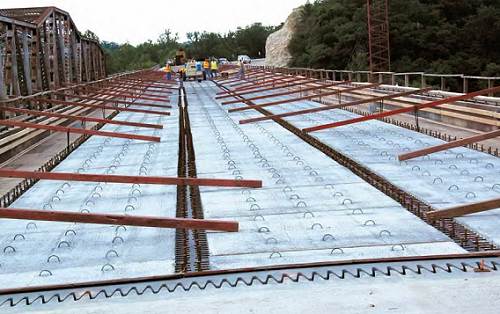
54 Subfloor of New Bridge
Work continues on the sub-deck for the Osage River bridge at Tuscumbia Friday, June 11. Once it is completed, the main deck can be laid down with a paving machine. Work after that will include the concrete sides to the bridge. Once the new bridge is open to traffic, the old bridge, at left, will be demolished, with all of the work scheduled to be finished by Oct. 1. The Missouri Department of Transportation’s resident engineer, Terry Imhoff, said a date for opening of the new bridge has not yet been set, but as of now he believes it will be in late July. MoDOT will hold a ribbon cutting and federal and state officials, along with local officials, are expected to take part. The date for that opening ceremony will be contingent on when various officials can attend and the contractor’s finish date, Imhoff said. MoDOT’s customer service department will coordinate the schedules and set up the ceremony.
Photo by Ginny DuffieldThat’s all for this week.
 Joe Pryor
Previous article links are in a dropdown menu at the top of all of the pages.
|

